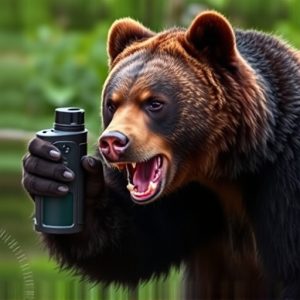Backcountry Safety: Demystifying Bear Spray as a Legal Deterrent
Bear spray, a non-lethal deterrent for aggressive bears, is not classified as a restricted weapon bu…….
Bear spray, a non-lethal deterrent for aggressive bears, is not classified as a restricted weapon but requires responsible handling. Its capsaicin ingredient irritates bears' senses, temporarily disorienting them. While effective with proper usage and understanding of range, wind, and bear behavior, it's not foolproof. Users must adhere to local regulations regarding type, quantity, and storage. Choosing the right spray from approved products and learning optimal deployment techniques is essential for safe backcountry travel.
“GrizGuard bear deterrent spray is your ultimate ally in the backcountry. This comprehensive guide explores the ins and outs of bear spray, delving into its effectiveness as a defense mechanism against aggressive bears. We navigate legal considerations, addressing the controversial status of bear spray as a restricted weapon in various regions. Learn how to choose the best bear deterrent spray for your adventures, ensuring safety and peace of mind while exploring nature’s untamed territories.”
- Understanding Bear Spray: The Basics and Its Effectiveness
- Legal Considerations: Is Bear Spray a Restricted Weapon?
- Choosing the Right Bear Deterrent Spray for Backcountry Adventures
Understanding Bear Spray: The Basics and Its Effectiveness
Bear spray, also known as grizzly repellent or defensive aerosol, is a powerful tool for backcountry adventurers and campers to protect themselves against aggressive bears. While often mistaken as a weapon, bear spray is not restricted like traditional firearms or knives. It’s a legal and effective deterrent when used properly in areas where bear encounters are common. The primary active ingredient in most bear sprays is capsaicin, the same compound that gives chili peppers their heat. This irritates the eyes, nose, and respiratory system of bears, temporarily disorienting them and creating an opportunity to escape or avoid confrontation.
The effectiveness of bear spray lies in its ease of use and quick reaction time. Unlike firearms, which require training and skill, bear spray can be deployed instantly when a bear approaches. Users simply point and spray, covering a wide area to deter the animal. However, it’s crucial to remember that bear spray is not a foolproof solution; it’s most effective when used in conjunction with other bear safety measures, such as making noise while hiking and storing food securely. Understanding the range, wind conditions, and the behavior of bears can also significantly enhance its utility as a backcountry protection tool.
Legal Considerations: Is Bear Spray a Restricted Weapon?
In many backcountry adventures, especially in regions with significant bear populations, the use of deterrents like bear spray has become a common practice for hikers and campers. One key question often arises: is bear spray considered a restricted weapon? The legal classification varies across jurisdictions, but generally, bear spray is not classified as a firearm or offensive weapon due to its non-lethal nature and specific design for wildlife deterrence. This means that in many national parks and wilderness areas, carrying bear spray is allowed without special permits or licenses, unlike other types of weapons.
However, there are still legal considerations to keep in mind. Some regions have specific regulations regarding the type, quantity, and strength of bear spray allowed. Additionally, users must handle and store bear spray responsibly to avoid misuse or accidental discharge. Understanding local laws is crucial for responsible outdoor recreation, ensuring both personal safety and compliance with relevant regulations.
Choosing the Right Bear Deterrent Spray for Backcountry Adventures
Choosing the right bear deterrent spray is crucial for anyone venturing into backcountry territories inhabited by bears. While bear spray isn’t considered a restricted weapon, selecting one requires understanding its purpose and limitations. Not all sprays are created equal; factors like active ingredients, range, and weather conditions play significant roles in their effectiveness.
When considering a bear deterrent spray, look for products approved by relevant outdoor organizations. Ensure the spray offers a good range—typically between 20 to 30 feet—and consider options with longer-lasting effects, especially if you’ll be navigating dense forests or humid environments that can impact performance. Remember, proper usage techniques are also vital; familiarize yourself with how and when to deploy the spray for optimal protection during your backcountry adventures.
Bear spray is an effective tool for backcountry adventurers, offering a safe and legal means of deterring bears. While concerns about its classification as a restricted weapon vary across regions, proper education and responsible usage ensure its functionality in protecting against bear encounters. When choosing a deterrent spray, consider factors like can size, spray pattern, and active ingredients to match your specific needs and outdoor pursuits. By understanding both the capabilities and limitations of bear spray, adventurers can make informed decisions, enhancing their safety during remote excursions.


